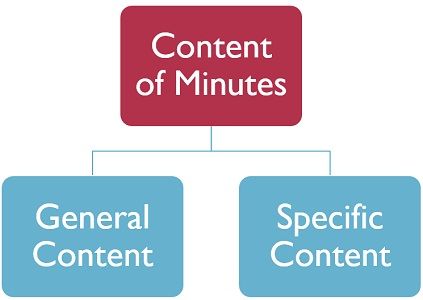Definition: Minutes, otherwise called as the Minutes of Meeting (MoM) is the immediate comprehensive written account of the meeting, explaining the business transacted at the meeting. It comprises of accurate and fair notes of the proceedings that happened at the meeting.
Contents of Minutes
The contents of the minutes are divided into two categories:
General Contents
It takes into account the basic details of the proceedings:
- Name of the company
- Date, Day, Place, and Time of beginning and conclusion of meeting
- When the meeting is adjourned, it shall state the original and the adjourned meeting,
- Name of the Directors (in alphabetical order beginning with the name of Chairperson) present.
- Name of the Company Secretary
Specific Contents
Among other things it should record:
- Election (if any) of the Chairperson.
- Existence of quorum.
- The total number of members personally present including representatives.
- The total number of proxies and the shares they represent.
- Presence of Chairman of various committees.
- Summary of the opening message of the Chairperson.
- Reading of qualifications, observations, comments or other remarks on the financial affairs, having any negative impact on the operation of the company, as stated in the Auditors report.
- Reading of qualifications, observations, comments or other remarks, as stated in the Secretarial Auditor report.
- With regard to resolutions, the type of resolution, name of members who proposed and seconded the resolution. Along with it, it records the majority of votes received. If any motion is moved so as to amed the resolution, the voting result on such motion has to be stated.
- When polling is done, Scrutinizer’s name and votes cast in favour and against the resolution and the invalid votes are recorded.
It is a source of information to those who are unable to attend the meeting and also to refer back the details whenever required.
Legal Requirements for preparation and maintenance of Minutes
- Every publicly listed company is required to prepare, sign and maintain minutes of the proceedings of the meeting, i.e. annual general meeting of members, creditors, board, committees of the board, or meeting called by requisitionist.
- When the resolution passed by postal ballot, a concise report on the postal ballot undertaken, concerning the proposed resolution, voting result and a sketch of the Scrutinizer’s report has to be included in the minutes’ book with date of such entry.
- Minutes shall be prepared within a period of thirty days of the conclusion of that meeting and kept in the books specifically maintained for that purpose, with pages numbered sequentially.
- A separate meeting book shall be maintained for each kind of meeting.
- General meeting
- Meeting of Creditors
- Board Meeting
- Meeting of Committee of the board.
- The appointments made at the meeting (Appointment of Director or Auditor) has to be contained in the minutes.
- It is up to the Chairperson who presides over the meeting, to decide what matters should be and should not be included in the minutes.
- If there is a board meeting or committee of the board, it shall also contain the name of the directors present at the meeting and each resolution taken at the meeting along with the name of the directors not agreeing with the resolution passed.
- It consists of the list of participants, issued raised, related responses, agreed outcomes and resolutions passed.
- It should serve as the evidence of the proceedings reported at the meeting.
- It should be duly signed and dated by the Chairperson.
Minutes book of the general meeting has to be retained at the Company’s Registered Office, whereas in case of a Board Meeting the minute’s book should be retained either at its Registered Office or any other place recommended by the Board.
It should be stored forever and that too under the aegis of the Company Secretary of the company or any director specifically authorized by the Company’s Board for this purpose.
Points to be considered while preparing Minutes
There are certain points which are to be kept in mind at the time of preparation of minutes. These are:
- Uniformity: There must be a uniform and consistent form in which minutes of the company are prepared. And if there is any alteration in such form, it must be authorized by the Board.
- Page Numbering: There must be a sequential numbering of the pages of the Minutes book, irrespective of its form, i.e. physical or electronic. Further, if any page or part is left blank, it should be crossed out and initialled by the Chairperson.
- Third Person: It should be written in the third person and past tense. Nevertheless, the resolutions should be entered in the present tense.
The recording of the proceeding of meetings is the duty of Company Secretary. However, if there is no Company Secretary, it should be recorded by any such person authorised by the Board or Chairman.

Leave a Reply